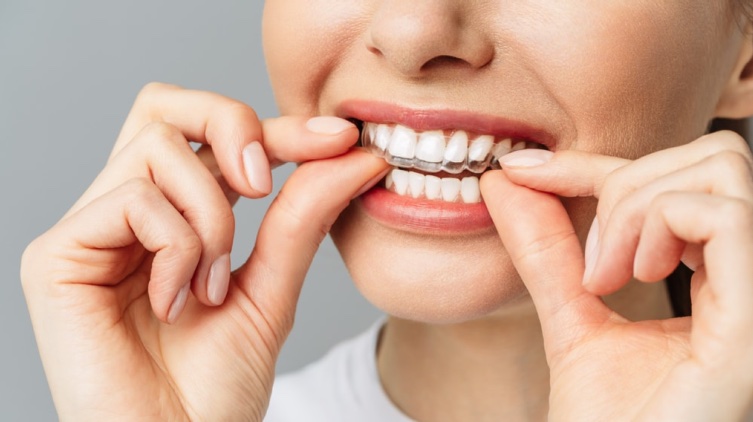 Porcelain veneers are one of the most popular cosmetic dentistry options available today. They can beautifully transform your smile by masking chips, stains, gaps, and other imperfections. But what if your teeth start shifting after you’ve already invested in veneers? Or what if you had veneers placed years ago and now wish your teeth were better aligned? A common question patients ask is: Can I still get Invisalign® if I already have porcelain veneers?
Porcelain veneers are one of the most popular cosmetic dentistry options available today. They can beautifully transform your smile by masking chips, stains, gaps, and other imperfections. But what if your teeth start shifting after you’ve already invested in veneers? Or what if you had veneers placed years ago and now wish your teeth were better aligned? A common question patients ask is: Can I still get Invisalign® if I already have porcelain veneers?
The answer is often yes, but with some important considerations.
Understanding Invisalign® and How It Works
Invisalign® is an advanced orthodontic system that uses a series of clear, removable aligners to gradually move your teeth into better alignment. Unlike traditional braces, Invisalign® aligners are nearly invisible and can be taken out when eating, brushing, or flossing. This treatment is designed using digital 3D scans that map out precise tooth movements over time.
Since Invisalign® relies on a snug fit around each tooth to apply gentle pressure, the condition and surface of your teeth, including any restorations like veneers, play a major role in how effective the treatment can be.
Can Invisalign® Be Used If You Have Veneers?
In many cases, Invisalign® can successfully be used for patients who have porcelain veneers, as long as a few key factors are evaluated first. The aligners can move natural teeth that do not have veneers and can sometimes move veneered teeth slightly, depending on how they were bonded and the direction of movement required.
However, there are limitations. Veneers are bonded to the front surface of your teeth and do not move with the underlying tooth structure the same way natural enamel does. Due to this, Invisalign® treatment must be planned very carefully to avoid damaging the veneers or compromising their bond.
Dr. Robert Rioseco, a highly experienced cosmetic dentist, customizes every Invisalign® treatment to each patient’s unique situation. Before recommending Invisalign® for someone with veneers, he performs a detailed evaluation to assess:
- The health and stability of the veneers
- How well the veneers are bonded to the natural teeth
- The amount and direction of movement needed
- The bite and alignment of both veneered and non-veneered teeth
In some cases, small, precise adjustments can be made safely with Invisalign®. In others, alternative approaches, such as minor recontouring, replacement veneers, or a combination of treatments, may deliver better long-term results. If you have yet to pursue either Invisalign® or porcelain veneers, it is usually recommended to undergo orthodontic treatment first.
How Invisalign® May Affect Veneers
As veneers are made from durable porcelain and securely bonded to the tooth, Invisalign® aligners typically do not harm them when treatment is properly planned and monitored. However, there are a few potential issues to consider:
Risk of Detachment:
If excessive pressure is applied to a veneered tooth during treatment, there’s a small risk that the veneer could loosen or detach. An experienced dentist like Dr. Rioseco will design your treatment plan to minimize these forces.
Attachment Limitations:
Invisalign® sometimes uses small, tooth-colored “attachments” to help guide movement. These attachments typically cannot be bonded directly to porcelain veneers. If attachments are needed, they will usually be placed on natural teeth instead.
Limited Tooth Movement:
Veneered teeth are best suited for minimal movement, such as small rotations or alignment refinements. Larger movements are generally more safely performed before veneers are placed.
Color and Fit Considerations:
If teeth shift significantly, existing veneers may no longer align perfectly with surrounding teeth or gums. This is another reason why careful planning and communication between you and your dentist are essential.
When Invisalign® and Veneers Work Well Together
If your veneers were placed primarily for cosmetic reasons, like to improve color or shape rather than correct major misalignment, Invisalign® can often be used safely afterward to fine-tune the position of your natural teeth. This can be especially helpful if you experience mild crowding or shifting over time.
In fact, many patients use Invisalign® to maintain their veneers’ appearance by ensuring the rest of their teeth stay properly aligned. In some cases, Invisalign® is even used before veneers are placed to achieve the ideal foundation for a more uniform, natural-looking smile makeover.
Benefits of Invisalign® for Veneer Patients
When performed by an experienced cosmetic dentist, Invisalign® offers several advantages for patients with veneers:
- Discreet treatment: The clear aligners allow you to straighten your smile without drawing attention to the process.
- Comfortable and removable: You can take them out to eat or clean your teeth, reducing the risk of plaque buildup around your veneers.
- Protects your investment: Keeping your teeth aligned helps prevent uneven wear and bite stress that could affect your veneers.
- Customized for your smile: Advanced digital planning ensures that every aligner fits precisely and moves your teeth safely.
When Invisalign® May Not Be the Best Option
While Invisalign® can often complement veneers, there are situations where it might not be the best choice. For example:
- You have severely misaligned teeth that require more complex orthodontic movements.
- Your veneers are older, loose, or damaged and may not tolerate the pressure of aligners.
- You need attachments on veneered teeth to achieve certain tooth movements.
In these cases, Dr. Rioseco may recommend addressing the underlying issue first, such as replacing aging veneers or exploring alternative orthodontic techniques, to achieve the best and safest results.
The Importance of a Skilled Cosmetic Dentist
Combining Invisalign® and porcelain veneers requires both orthodontic expertise and advanced aesthetic judgment. A Fellow of the Academy of General Dentistry and a member of the American Academy of Clear Aligners, Dr. Rioseco combines exceptional cosmetic training with advanced expertise to create treatments that balance function, health, and beauty. He carefully evaluates how your teeth, veneers, bite, and facial features work together to create a result that looks natural and lasts.
Schedule a Consultation
If you’re wondering whether Invisalign® is right for you, even if you already have porcelain veneers, the best next step is to schedule a consultation with Dr. Robert Rioseco at The Center for Cosmetic Dentistry. During your visit, Dr. Rioseco will examine your smile, discuss your goals, and create a personalized plan to help you achieve a beautifully aligned, confident smile that enhances your existing dental work.
Contact The Center for Cosmetic Dentistry to learn more about Invisalign® with porcelain veneers or to schedule your consultation with Dr. Rioseco.

